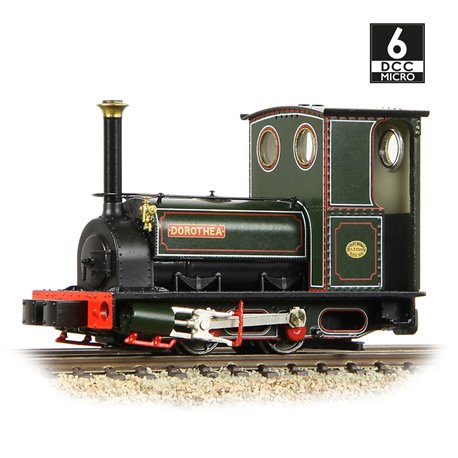No products
Product successfully added to your shopping cart
There are 0 items in your cart. There is 1 item in your cart.
Quarry Hunslet 0-4-0 Tank 'Dorothea' Dorothea Quarry Lined Green
391-053
Graham Farish
Quarry Hunslet 0-4-0 Tank 'Dorothea' Dorothea Quarry Lined Green
This product is out of stock
More info
Quarry Hunslet Steam Locomotive ‘Dorothea’ in Dorothea Quarry Lined Green livery. Barely larger than a 9V battery, this diminutive model still packs a punch with its diecast boiler and running plate, accompanied by a wealth of separately fitted details including handrails, valves, springs, brake shoes and cab controls. The 0-4-0ST wheel formation is faithfully modelled, with authentically-profiled wheels running in metal bearings ensuring smooth running, powered by a coreless motor with flywheel, and with a 6 Pin DCC decoder socket for those wishing to use the models with a DCC system. NEM coupling pockets feature at both ends, into which standard OO9 scale couplings are fitted.
MODEL FEATURES:
- Bachmann Narrow Gauge OO9 Scale
- Era 2
- Pristine Dorothea Quarry Lined Green livery
- Named ‘Dorothea’
- Etched Name Plates and Works Plates Included
- NEM Coupling Pockets
- Powerful Coreless Motor and Flywheel
- Detailed and decorated cab interior
- Equipped with a 6 Pin (Micro) DCC Decoder Socket
- Length 58mm (over couplings)
DETAIL VARIATIONS SPECIFIC TO THIS MODEL
- Late-type ‘Port’ Enclosed Cab
- Angled Frames
- Piston Access Holes in front Bufferbeam
- Backhead Injectors
- Ramsbottom Safety Valves
- Riveted Water Tank
- Wrap Around Tank Handrail
- Twin Smokebox-mounted Lubricators
- Blower supply fitted to right hand side of locomotive
QUARRY HUNSLET ‘DOROTHEA’ HISTORY
The Quarry Hunslet locomotives were built by the Hunslet Engine Company of Leeds. Rather than denoting a single design, the term Quarry Hunslet refers to several different locomotive types, each built to a similar design, but with specifics suited to their intended use. The first Quarry Hunslets were the Penrhyn Port Class, built for shunting duties at Port Penrhyn, the coastal port of Penrhyn Quarry – once the largest slate quarry in the world. These locomotives sported a 4ft wheelbase and the first example was delivered in 1883.
In 1886 the nearby Dinorwic Quarry, Wales’s second largest slate quarry, took delivery of its first Quarry Hunslet, named ‘Velinheli’. Smaller than the Penrhyn locos with a wheelbase of just 3ft 3in, the second Dinorwic loco, delivered in 1889 and originally named ‘Alice’, would lend its name to the locomotive type and by 1904 eleven Alice Class Quarry Hunslets had been delivered to the Dinorwic Quarry. All were built to fundamentally the same design, although details inevitably changed over the years, but a notable feature of the Alice Class locos was the angled frames and resulting shallow bufferbeams at the front and rear. At the quarry the locomotives were moved between the various galleries and to and from works via the steep inclined planes – straight frames would bottom out on these steep inclines, a problem avoided by building the locos with angled frames.
Five similar locomotives were built for use at Port Dinorwic during the same period, these shared much the same design as the Alice Class locos but had straight frames which resulted in them sporting much deeper bufferbeams. The Alice Class also provided the blueprint for six more engines which were built for smaller concerns; the Pen-Yr-Orsedd Quarry which took three, Moel Tryfan Quarry had two, and a single example was delivered to the Dorothea Quarry. The Penrhyn Quarry placed orders for four of these smaller 3ft 3in. wheelbase locomotives too – these became known as the Penrhyn Small Quarry Class to avoid any association with their rivals the Dinorwic Quarry. Penrhyn Quarry would later order another six Quarry Hunslets, but these reverted to the 4ft wheelbase used on the Penrhyn Port Class locos; whilst very similar in design, this final batch of Quarry Hunslets were different enough to be known instead as the Penrhyn Large Quarry Class.
‘Dorothea’ was the only Quarry Hunslet locomotive ordered by the Dorothea Slate Quarry in North Wales. Built as works number 763 and delivered in 1901, ‘Dorothea’ had an enclosed cab from new and worked at the quarry until the early-1940s, when she was abandoned in a collapsing shed at the top of a hill. Subsequently stripped for parts which were sold to keep other engines running, and without her cab which had been removed and used as a blast shelter, the remains of ‘Dorothea’ were rescued by enthusiast Dave Walker in 1970 – who was also able to purchase the cab-cum-blast shelter following the quarry’s closure. Most of the lost parts had been acquired by 1975 and when the owner moved to Cornwall so did ‘Dorothea’, being stored in the car park of the Launceston Steam Railway. Offered for sale in 1989, Nigel and Kay Bowman became the new owners – Nigel (founder of the Launceston Steam Railway) had seen ‘Dorothea’ back in 1964 and had concluded it was an impossible restoration project, which gave his wife even greater determination to complete the challenge!
After more than twenty years of hard work, Kay returned ‘Dorothea’ to steam, hauling her first passenger trains over the Easter weekend in 2012. For this restoration, Kay Bowman was subsequently awarded the John Coiley award for Locomotive Preservation by the Heritage Railway Association. The final cosmetic elements of the restoration have continued during the following years, when the locomotive is not at work hauling trains on the Launceston Steam Railway.



